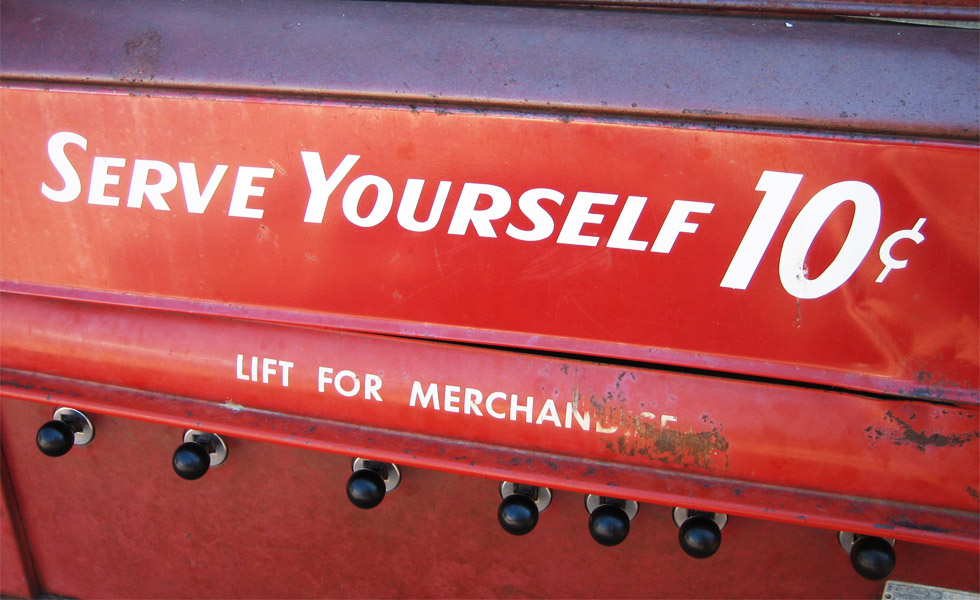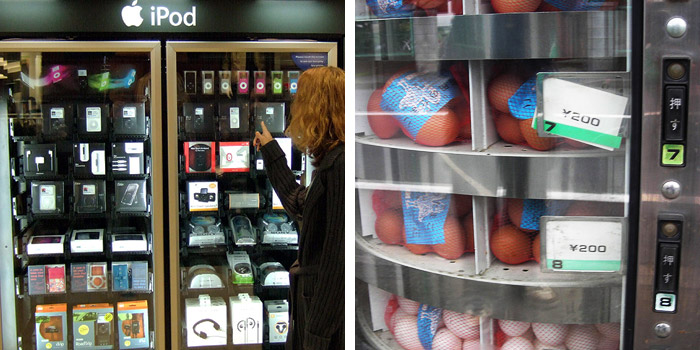Vending machines: Experience design in a box
Comments: +
January 7 2010

Vending machines were like the pre-digital internet, where busy shoppers made purchases immediately, day or night. Why do we still love these mechanical outposts selling everything from pretzels to iPods? Perhaps it’s the joy of not having to deal with another human.
The internet is today’s default mode for millions of shoppers who buy everything from cars to groceries with a few quick clicks of the mouse, but the very first anonymous transaction originated with the vending machine. Invented by first-century Greek mathematician Hero to dispense holy water, vending machines didn’t see widespread use until the late 19th century, when they sold postcards and paperback books.
It isn’t just the impersonal ease and efficiency of buying something on the spot that keeps vending machines in our 21st-century lives. There’s still a certain little-kid joy in feeding money into a slot and watching the mechanical components behind the shiny plate glass deliver it instantly to you. It’s experience design in a miniature format, a private performance set in motion at your command. More to the point, it’s fun.

Vending machines offer instant gratification when stores are closed and we need something right now. They keep us from feeling desperate, providing food when the cafeteria is closed, supplying cold drinks in hostile locations like the offices of the Department of Motor Vehicles. In addition to the familiar dispensers of chips, candy bars, and Cokes, there’s a vending machine that makes and delivers a fresh hot pizza in about 3 minutes, and another that sells cans of bread. In case you’re speeding by and happen to need a dozen fresh eggs, Japanese country farmers sell them roadside out of refrigerated vending machines.
Practicality figures into a number of vending-machine-ready situations. Redbox has more than 15,000 vending machines renting out DVDs for one dollar; the selection isn’t close to what you’d find on Netflix or your local rental joint, but the price is right and the convenience can more than make up for the limited choices. In 2008, Best Buy rolled out vending kiosks at eight U.S. airports to sell the cables, connectors, and travel adapters without which all work ceases. (You know, that stuff you left at home on your dresser.) There are even medication-dispensing vending machines, and those that sell flat shoes for the aching feet of British late-night clubgoers.

In our snarky age of irony, what was once a simple delivery system for inexpensive, disposable items like cigarettes or packs of gum now dispenses the valuable: nuggets of gold, $400 marabou-feather vests, and luxury car rentals (Rolls Royce Silver Shadow, anyone?). iPod ZoomShops, located in especially busy retail locations and airports, have a uniform aesthetic with the product they peddle. It somehow makes sense to buy a high-tech item from a hermetically sealed machine, as if no one’s fingerprints but your own will mar the gleaming object. You don’t have to think about or chat with the person who loaded your iPod into the machine; you’ll never see him.
Freed from regular business hours and the burden of making awkward small talk with the customer, the vending machine is always open, always ready, and does not offer up an opinion on your purchase. Once at Barney’s when I requested a pair of stockings, a snide little salesman raised one eyebrow and asked in a tone of mock solicitude, “Control top?” Um, no thanks, I’ll just be running along. I’ll grab a pair from the nearest vending machine.
Angela Riechers is a graphic designer and second year MFA student in the new Design Criticism program at the School of Visual Arts. Previously, she was Art Director of Home Magazine and taught undergraduate graphic design at SVA and The City College of New York. You can find her design work at www.angelariechers.com, and blog posts at NounVerbDesign.
Filed under: culture
Comments